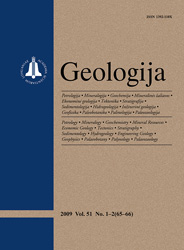Geologija / Geology
WHAT?
 ISSN 1392-110X ISSN 2029-056X (online) |
2007 m. Nr. 1 Uranium–Thorium isochron dating results of
penultimate (Late Mid–Pleistocene) Interglacial in
Lithuania from Mardasavas site
The Snaigupėlė Interglacial gyttja was dated first by the uranium–thorium isochron method in the Mardasavas parastratotype section, Southeastern Lithuania. The isochroncorrected 230Th / U ages are 202.4 + 38.6/ – 22.9 ka (TSD method) and 220.6 + 35.3 / –20.5 ka (L / L method). Theses dates correspond to the second part of the Interglacial. The range of the obtained ages is close to the age limit of the MOIS 7 stage of deep sea sediments (186–242 ka). The 230Th / U dates obtained on gyttja from the Mardasavas section are in fact the corresponding deposits of the penultimate (Snaigupėlė) Interglacial within MOIS 7 present in Lithuania. One more Interglacial warming (Snaigupėlė = Drenthe-Wartha = Cherepet) is recognized between the Butėnai = Holsteinian = Likhvinian Interglacial of the Middle Pleistocene and the Merkinė = Eemian = Mikulino = Kazantsovian Interglacial of the Late Pleistocene. The warm climate event of MOIS 7 is of broad transcontinental or even hemispheral significance rather than a local phenomenon in the East European Plain. Keywords: uranium–thorium dates, gyttja, Snaigupėlė Interglacial, Mardasavas, Lithuania |
Issues:
2011 - Vol.53 No. 1, No. 2, No. 3 2010 - Vol.52 No. 1-4 2009 - Vol.51 No. 1-2, No. 3-4 2008 - Vol.50 No. 1, No. 2, No. 3, No. 4, No. Priedas 2007 No. 1, No. 2, No. 3, No. 4 2006 No. 1, No. 2, No. 3, No. 4 2005 No. 1, No. 2, No. 3, No. 4 2004 No. 1, No. 2, No. 3, No. 4 2003 No. 1, No. 2, No. 3, No. 4 2002 No. 1, No. 2, No. 3, No. 4 2001 No. 1, No. 2, No. 3, No. 4 |